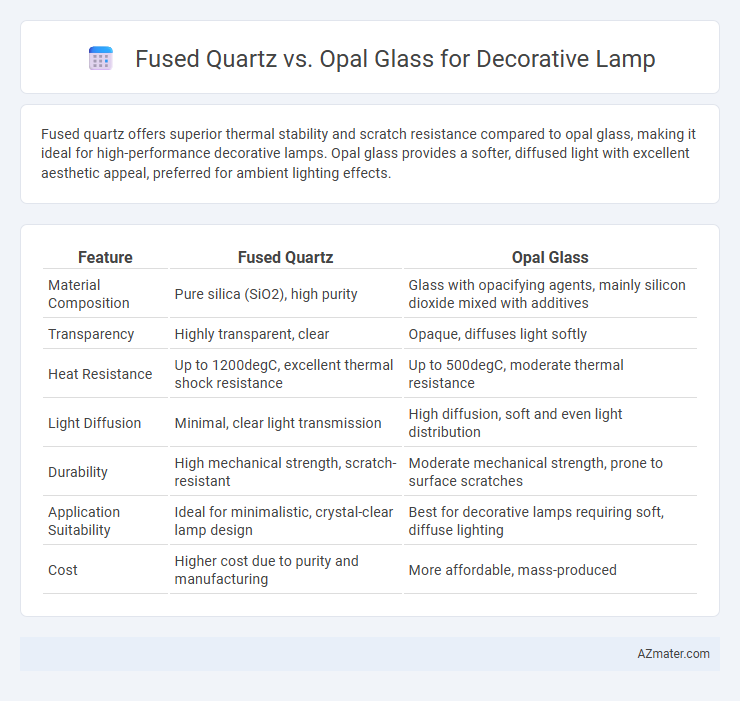Fused quartz offers superior thermal stability and scratch resistance compared to opal glass, making it ideal for high-performance decorative lamps. Opal glass provides a softer, diffused light with excellent aesthetic appeal, preferred for ambient lighting effects.
Table of Comparison
| Feature | Fused Quartz | Opal Glass |
|---|---|---|
| Material Composition | Pure silica (SiO2), high purity | Glass with opacifying agents, mainly silicon dioxide mixed with additives |
| Transparency | Highly transparent, clear | Opaque, diffuses light softly |
| Heat Resistance | Up to 1200degC, excellent thermal shock resistance | Up to 500degC, moderate thermal resistance |
| Light Diffusion | Minimal, clear light transmission | High diffusion, soft and even light distribution |
| Durability | High mechanical strength, scratch-resistant | Moderate mechanical strength, prone to surface scratches |
| Application Suitability | Ideal for minimalistic, crystal-clear lamp design | Best for decorative lamps requiring soft, diffuse lighting |
| Cost | Higher cost due to purity and manufacturing | More affordable, mass-produced |
Introduction: Fused Quartz vs Opal Glass in Decorative Lamps
Fused quartz offers exceptional thermal resistance and durability, making it ideal for decorative lamps exposed to high temperatures or frequent use. Opal glass provides a soft, diffused light effect that enhances aesthetic appeal with its smooth, milky finish, favored in ambient lighting designs. Comparing fused quartz and opal glass involves balancing heat tolerance against decorative softness to select the best material for specific lamp styles.
Material Composition and Manufacturing Processes
Fused quartz consists primarily of pure silicon dioxide (SiO2) formed by melting high-purity quartz crystals at extremely high temperatures, resulting in a highly transparent, durable, and thermally resistant material ideal for decorative lamps. Opal glass is made by adding opacifiers such as tin or bone ash to molten silica, creating a milky, diffused appearance that softens light emission for aesthetic ambiance. Manufacturing fused quartz involves flame fusion or electric melting techniques producing a homogeneous structure, while opal glass is typically formed by conventional glass melting and controlled crystallization processes to achieve its characteristic opaqueness.
Light Transmission and Diffusion Properties
Fused quartz exhibits exceptional light transmission with over 90% clarity in the visible spectrum, offering minimal color distortion and high resistance to UV degradation, making it ideal for applications requiring pure and intense illumination. Opal glass provides superior light diffusion due to its milky, translucent nature, effectively softening glare and creating a uniform, ambient glow that reduces harsh shadows in decorative lamps. While fused quartz emphasizes brightness and clarity, opal glass prioritizes even light distribution, allowing designers to choose based on whether sharp illumination or gentle diffusion is desired.
Aesthetic Appeal: Clarity vs. Soft Glow
Fused quartz offers exceptional clarity and high transparency, making it ideal for decorative lamps that emphasize sharp, brilliant light and intricate detail visibility. Opal glass produces a soft, diffused glow that creates a warm and inviting ambiance, enhancing the lamp's aesthetic appeal through gentle illumination rather than clarity. Choosing between fused quartz and opal glass depends on whether the desired effect prioritizes crystal-clear radiance or a soothing, evenly dispersed light.
Durability and Resistance to Temperature
Fused quartz demonstrates superior durability and exceptional resistance to high temperatures, withstanding thermal shock up to 1,100degC, making it ideal for decorative lamps exposed to intense heat. Opal glass, while visually appealing with its diffuse light quality, offers moderate thermal resistance, typically up to 500degC, and is more prone to cracking under rapid temperature changes. The enhanced mechanical strength and low thermal expansion of fused quartz ensure longer-lasting performance in demanding lighting applications.
Color Options and Customization Potential
Fused quartz offers limited color options, typically available in clear or slightly tinted varieties, emphasizing purity and high-temperature resistance, while opal glass excels with a diverse palette, including various pastel and opaque shades ideal for decorative lamps. Opal glass allows greater customization potential with its ability to diffuse light softly and accept surface treatments such as etching and frosting, enhancing aesthetic versatility. In contrast, fused quartz is primarily chosen for its durability and clarity rather than extensive color or decorative customization.
Cost Comparison: Investment and Longevity
Fused quartz, known for its superior thermal stability and durability, demands a higher initial investment compared to opal glass but offers exceptional longevity, reducing replacement frequency. Opal glass, while more affordable upfront, tends to have a shorter lifespan due to susceptibility to chipping and heat damage, potentially increasing long-term costs. Investing in fused quartz can lead to cost savings over time through enhanced durability and reduced maintenance in decorative lamp applications.
Maintenance and Cleaning Requirements
Fused quartz offers superior chemical resistance and can withstand aggressive cleaning agents, making it ideal for decorative lamps requiring frequent maintenance. Opal glass, while aesthetically pleasing with its uniform translucency, is more susceptible to surface damage and staining from harsh cleaners, necessitating gentle cleaning with mild detergents. Regular cleaning of fused quartz ensures minimal degradation over time, whereas opal glass demands careful handling to preserve its appearance and prevent clouding.
Environmental Impact and Sustainability
Fused quartz exhibits superior environmental sustainability due to its higher durability and resistance to thermal shock, reducing the need for frequent replacements and minimizing waste. Opal glass, while aesthetically versatile, typically requires more energy-intensive production processes and has a shorter lifecycle, contributing to a larger carbon footprint. Choosing fused quartz for decorative lamps supports eco-friendly practices by enhancing product longevity and lowering overall environmental impact.
Best Applications for Fused Quartz and Opal Glass Lamps
Fused quartz lamps excel in high-temperature environments and UV light applications due to their exceptional thermal stability and low thermal expansion, making them ideal for decorative lamps requiring durability and clarity under intense heat. Opal glass lamps provide a soft, diffused glow with excellent light-scattering properties, perfect for ambient lighting and aesthetic designs where warm, uniform illumination enhances interior decor. Choosing fused quartz suits industrial or outdoor decorative lamps exposed to heat, while opal glass is favored for indoor fixtures emphasizing ambiance and visual comfort.

Infographic: Fused quartz vs Opal glass for Decorative lamp
 azmater.com
azmater.com